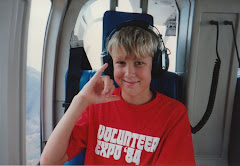Given that helicopters can rise and descend vertically, why would a pilot opt for a more modest angle?
Three words: Effective translational lift.
Helicopter rotor blades are basically airplane wings that spin in a circle (the rotor disc). Like wings, they create lift when air moves smoothly across their upper surface.
When a helicopter is hovering without any forward movement, it's dragging the air above it straight down through the rotor disc. The blades still create lift, because they are moving horizontally through the air like wings, but the effect is partially corrupted by the air that is descending vertically.
 Due to this confused or "dirty" air, the engine has to work pretty hard to generate enough lift to maintain a hover.
Due to this confused or "dirty" air, the engine has to work pretty hard to generate enough lift to maintain a hover.As a helicopter adds forward speed, the dirty air is pushed farther and farther to the rear of the rotor disc by undisturbed "clean" air ahead. The faster the helicopter moves forward, the cleaner and more horizontal the air flow, and the greater the lift generated by the blades.
This dynamic is called effective translational lift, or ETL. Effective translational lift increases as the helicopter accelerates forward during take off, eventually reaching a strength that enables the pilot to pull the helicopter into the sky, similar to an airplane.
 Weirdly, with ETL the helicopter can actually climb using less engine power than what is required to hover.
Weirdly, with ETL the helicopter can actually climb using less engine power than what is required to hover.Although helicopters do typically have enough muscle to climb vertically through dirty air, it's safer to take advantage of ETL. A vertically climbing helicopter is more vulnerable to an irreversible -- and likely fatal -- rotor stall, for reasons I'll explain in another post.
If a helicopter is heavily loaded, or under certain conditions of air temperature, air pressure, humidity, and wind, the pilot may have no choice but to climb using forward movement and ETL.
 In Chickenhawk, a riveting first-hand account of the helicopter war in Vietnam, pilot Robert Mason is forced to rely on ETL to lift his overloaded Huey -- filled with infantry -- out of battlefields being overrun by Viet Cong.
In Chickenhawk, a riveting first-hand account of the helicopter war in Vietnam, pilot Robert Mason is forced to rely on ETL to lift his overloaded Huey -- filled with infantry -- out of battlefields being overrun by Viet Cong.The same dynamic applies to landings. Rather than descending vertically, helicopter pilots will typically maintain forward speed (and ETL) all the way to the final hover over the landing spot.




2 comments:
This is extremely useful imformation. I am 17 and am interested in flying helicopters. I am doing a bit of my own research before I actually go to school. Your blogs are very very very helpful! THANK YOU!
thank you for this informative blog post. It would be much better if you also share the basic techniques of handling a private jet
when taking off and safety landing.
Post a Comment